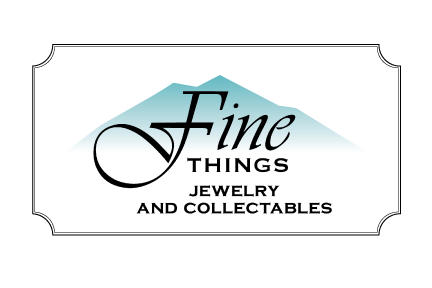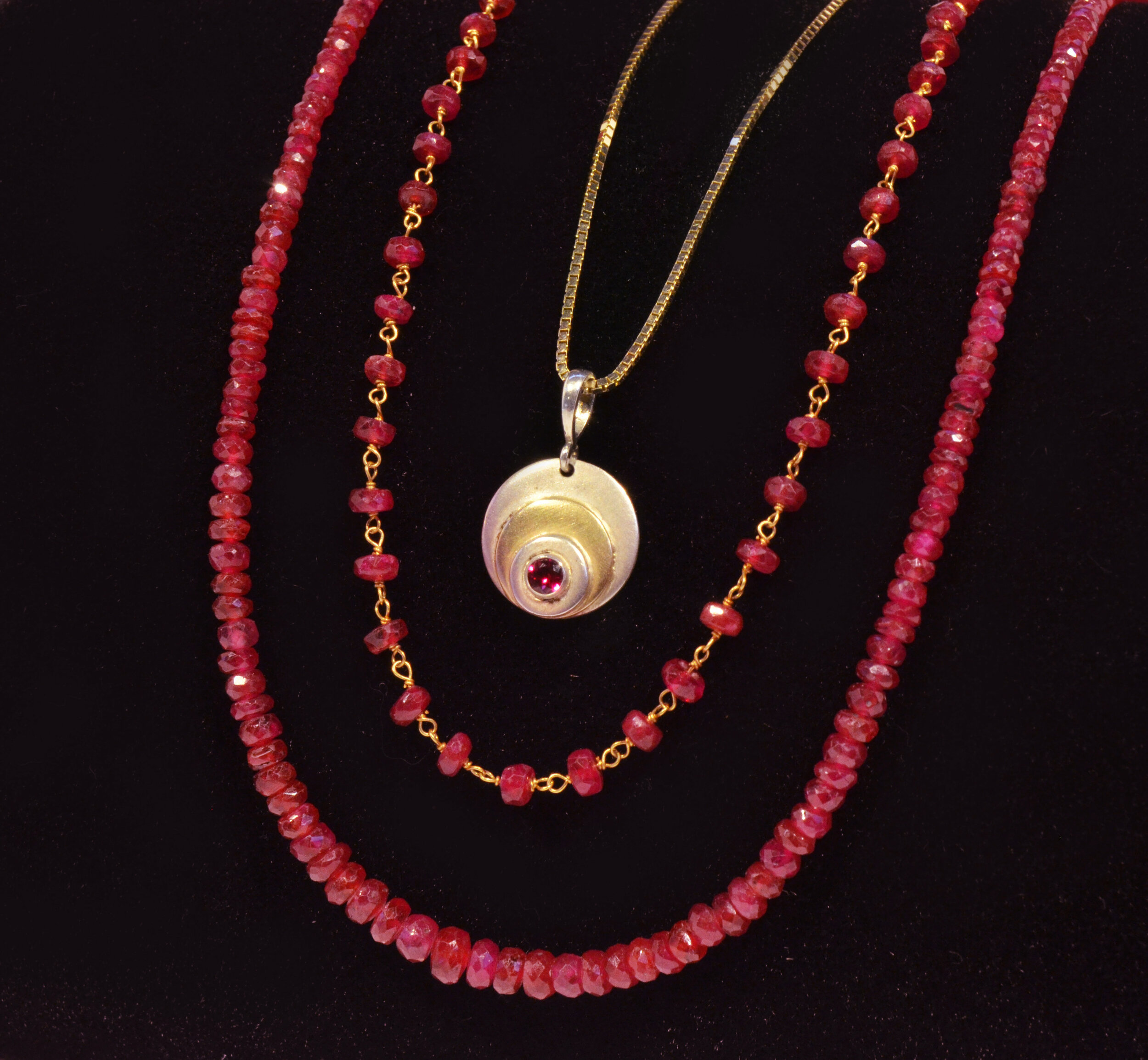Ruby - Birthstone of July
Ruby is the birthstone for July and one of the most coveted of all gems. Recognized as the world’s most valued gemstone for centuries, ruby holds the undisputed title as the “King of Gems,” and in Sanskrit, Ruby is “Ratnaraj”, which means the “King of Gems”.
Ruby is all about passion – penetrating the heart with color and fire like no other gemstone. Unmatched in legend and seldom rivaled in beauty, it combines the energy of light with the power of fire into a single breathtaking scarlet-colored gem.
Named for its rarity, hardness (second only to diamond), beauty, and seemingly mystical powers, Ruby represents passion, love, and success. Ruby is the most valuable variety of the corundum mineral species, which also includes sapphire. Ruby can command the highest per-carat price of any colored stone.
Definition:
The name is derived from the Latin word “ruber”, meaning “red”, the color of love and passion. The finest color of this birthstone is a deep red with a hint of purple, called “pigeon’s blood” in the trade. Ruby is a variety of the mineral corundum, and gets its color from trace amounts of the element chromium. Chromium is the trace element that causes ruby’s red, which ranges from an orangey-red to a purplish-red. The more chromium, the stronger the red. Chromium can also cause fluorescence, which adds to the intensity of the red color.

The History of Ruby:
Ruby is one of the most historically significant colored stones. It is mentioned four times in the Bible, in association with attributes like beauty and wisdom. Ruby has been called the most precious of the 12 stones created by God. In the first century AD, the Roman scholar Pliny included rubies in his “Natural History”, describing their hardness and density.
Ancient Hindus believed that those who offered fine rubies to the god Krishna were granted rebirth as emperors. Hindus divided ruby into four castes, calling the true Oriental ruby a Brahmin. Someone in possession of a Brahmin was believed to have the advantage of perfect safety.
In China, a Mandarin’s rank was indicated by the color of the stone in his ruby ring. A red jewel stone meant he was a key figure among the great. In the 1880’s, French jewelers called the ruby the gem of all gems or the dearly loved stone.
People of India believed that rubies enabled their owners to live in peace with their enemies. It was also long associated with the life force blood, Ruby was a symbol of power and youthful energy in Indian Jewelry. In past centuries, some believed this birthstone for July could predict misfortune or danger, and others claimed it would cure inflammatory diseases and soothe anger.
In Burma (a source since at least 600 AD), warriors believed it made them invincible in battle. However, it wasn’t enough to just wear the rubies. They had to insert them into their flesh and make them part of their bodies.
Many medieval Europeans maintained that rubies bestowed health, wisdom, wealth and success in love. Ruby has retained its importance and has become one of the most sought after gems of European royalty and the upper classes. As a symbol of passion, ruby makes an ideal romantic gift. Its lush color also signifies wealth and success.
Symbolism:
Ruby encourages passion for life but never in a self-destructive way. It improves motivation and setting of realistic goals. Ruby stimulates the heart chakra and balances the heart. Ruby is a powerful shield against psychic attack. It promotes positive dreams and clear visualization, and stimulates the pineal gland. Ruby is one of the stones of abundance and aids retaining wealth and passion.
Psychologically, Ruby brings up anger or negative energy for transmutation and encourages removal of anything negative from your path. It promotes dynamic leadership.
Mentally, Ruby brings about a positive and courageous state of mind. Under the influence of Ruby, the mind is sharp with heightened awareness and excellent concentration. Given this stone’s protective effect, it makes one stronger during disputes or controversy.
Emotionally, Ruby is dynamic. It charges up passion and fires the enthusiasm. Ruby is a sociable stone that attracts sexual activity.
Physically, Ruby overcomes exhaustion and lethargy and imparts potency and vigor. Conversely, it calms hyperactivity.
Northern Vietnam paddy fields
Location:
Our search for the July Birthstone starts in Myanmar (formerly known as Burma), one of the oldest recorded sources of Rubies. For more than five centuries, the Mogok area in Myanmar has produced some of the most sought after rubies – vibrant red beauties softened by “light-scattering inclusions” and a glowing red fluorescence. The region is a place of weathered marble and ancient Buddhist temples.
Since the late 20th century, Vietnam has been another important source of the July Birthstone. The Luc Yen region in northern Vietnam, where rainforest clad mountains rise over broad paddy fields, produces rubies of red to purplish-red color. Farther south, the Quy Chau district has also yielded many fine rubies. Today, artisanal miners work the soil in hopes of finding a gem that will change their fortunes.
For many years in the late 1900s, the ruby deposits along the border between Thailand and Cambodia were the major source of rubies in the marketplace. Other important producers of rubies include Afghanistan, Tajikista, Pakistan, Sri Lanka, Kenya, Tanzania and Madagascar.
Mozambique is also an important new source of rubies. This African nation is home to the prolific mines at Montepuez. Rubies found there have been compared to the famed gems of Mogok.
Care & Cleaning:
Ruby is a 9 on the Mohs scale of hardness, making it a great gemstone for everyday wear.
Rubies are often heat treated to remove purplish coloration, leaving a purer red. The process can also remove “silk” (minute needle-like inclusions) that can cause a gem to appear lighter in tone and be more opaque. The trade typically accepts heat treatment, as it is stable to normal conditions of wear and care. However, rubies may also be subjected to lattice diffusion treatment and dyeing. In lower quality material, surface-reaching fractures and cavities may be filled with a glass to decrease their visibility so the gem appears more transparent. Some of these treatments may make the ruby more vulnerable to damage during normal wear and care.
Before you buy, always ask if your ruby has been treated and by what method. The Federal Trade Commission requires disclosure of treatments that affect a gemstone’s perceived value. A GIA Identification Report is important in identifying if a stone is natural or synthetic and whether it has been treated in any fashion.
In most cases, the July Birthstone, can be safely cleaned with warm, soapy water and a soft brush. Ultrasonic and steam cleaners are usually safe for untreated, heat-treated and lattice diffusion-treated stones. Glass-filled or dyed stones should only be cleaned with a damp cloth.
Why We Love This Gemstone
Intense Red Glow:
Fine Ruby glows with intense red in sunlight thanks to red fluorescence, which intensifies its red color.
First Laser:
The first laser was created in 1960 using the red fluorescence light emitted by ruby.
Chromium:
Chromium causes ruby’s red. Gemologists consider it the “rock star” of trace elements.
COLOR
Color is the most significant factor affecting a ruby’s value: Fine gems are a pure, vibrant red to slightly purplish-red.
CLARITY
If a Ruby’s inclusions affect its transparency or brilliance they reduce the gem’s value significantly.
CUT
Rubies are commonly fashioned as mixed cuts, which have brilliant-cut crowns and step-cut pavilions.
CARAT
Fine quality Rubies over one carat are very rare and price goes up significantly as size increases.


